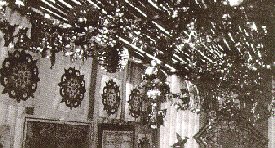
Sukkot will be held this year from Monday evening, October 5th to Sunday evening, October 11th.
Joyous Festival
Sukkot is one of the most joyous festivals in the Jewish calendar, and, as such, it marks a drastic transition from the solemn days that precede the holiday (Rosh Hashanah and Yom Kippur). Sukkot is the Hebrew word for ‘huts’, and refers to the temporary homes that were used by the Jews in the wilderness thousands of years ago, after they were slaves in Egypt. We celebrate Sukkot as a reminder of our people’s life in the desert.
Sukkot, the Festival of Joy, catches everyone’s imagination: images of flags, Torah dancing and shaking lulavim. Sukkot has many symbols that recalls the Israelites’ journey through the desert. The Talmud recalls a special ceremony of ‘water libation’ curing the seven days of Sukkot (Sukkot 4:9). This is reflected today in the Simchat Belt HaShoeva, with its incredibly joyous and energetic dancing and singing.
Why Make “Sukkos”?
According to the Torah, we are to move out of our houses on the fifteenth day of the Month of Tishrei and to make sukkos for seven days in the outdoor Sukkah. The reason given is that living in ‘sukkos’ reminds us of the special protection the Jewish people got from the rough desert when we were freed as slaves from Egypt.
People say that eating festive meals and spending time in the outdoor Sukkah is a delightful and unique religious experience. Some people decorate the Sukkah with elaborate ornaments; others prefer to keep it simple.
How To Build the Sukkah?
The actual name Sukkot actually refers to the booths, or temporary dwellings, that we are commanded to live in during the holiday. The Sukkah reminds us of the forty-year period during which the Children of Israel wandered in the desert.
Any Rabbi can advise you how to build or purchase a proper Sukkah. One Rabbi explains that “the most elementary lesson of all is the sense of ‘temporariness.’Although we are certainly expected to make every effort to dignify this mitzvah by making the sukkah as attractive as possible and to truly fulfill our Sages’ guideline that ‘you shall dwell in them as you live in your own home,’ there is no escaping the feeling that this is only a ‘temporary dwelling.’ when dining room, living room and bedroom all become combined in an area equal in size to only one of these units, and when furniture is kept down to a bare minimum, the dwellers of the sukkah are keenly aware that this is not a permanent situation.”
Dovid Gross, a reporter with Virtual Jerusalem, explains that “A sukkah must have at least three walls. The fourth side can be left open, if necessary… the walls of the sukkah may be of any material, and fixed so they won’t easily blow down in the wind. These walls can even be on the side of a building… a sukkah can be small enough for one person or big enough for hundreds of people… if you’ve ever wondered why most Jerusalem apartments have a porch (mirpeset), it’s because they’re easily made into a sukkah! Add some walls, decorate, and you’re done!…”
“You shall hold a festival for the Lord your God, seven days, in the place the Lord will choose; for the Lord, your God will bless all your crops and all your undertakings, and you shall have nothing but joy” (Deuteronomy 16:1)
You’d be surprised with how creative some Israelis are… he mentioned one unique set up: a “porch [that] is enclosed year-round, but the roof slides away. By placing sekhakh on top this becomes a kosher sukkah… The ‘temporary’ aspect of the sukkah is in its roof. The material used to build it is called ‘sekhakh’. Anything which grows from the ground (and is now cut from the ground qualifies, meaning you couldn’t just drape growing vines over your walls. Also, the material can’t be subject to ritual impurity (tumah), which excludes fruits, for example. So, branches cut off from trees and bushes, bamboo reeds and sticks all qualify. Here in Israel we use palm branches… Today, many people buy sekhakh in the form of woven mats, manufactured especially for the purpose of Sukkot. You can buy them in a variety of sizes an textures… the sukkah is usually decorated to make it inviting and cheery. It is customary to hang different fruits from the sukkah, and to hang pictures and decorations from the wall.”
Generally, we decorate the Sukkah with natural, growing things, similar to the way it was made during the time of our ancestors. Today, many people also decorate their Sukkah with paper decorations. Fruits, pictures and crafts are often used as decorations.
Sukkot Customs
The Four Species are four different kinds of growing things, which represent all growing things in the world. They are lulav, etrog, willow branch and myrtle branch. We hold the Four Species when we recite special prayers of thanks to God during Sukkot.
Ushpizin, an Aramaic word for guests, refers to seven of our ancestors Abraham, Isaac, Jacob, Moses, Aaron, Joseph, and David – who are believed to be our guests in our Sukkah – one each day – in the same way that Elijah visits us at the Passover Seder. Like the glass of wine left at the Seder table for Elijah, some people leave chairs in the Sukkah for the Ushpizin. Many people put Ushpizin plaques up in their Sukkah to be reminded of our ancestors.
Sukkot is also a pilgrim festival, where we celebrate nature and agriculture. It was at this time of year, at the end of the farming season, that the farmers went to the Temple in Jerusalem to give thanks to God for their harvests. Because rain is such an important aspect of the harvest season, there were many water celebrations during the time of the Temple, as well.
The eighth day of Sukkot is called Shmini Atzeret, a solemn day, where we pray for rain for the coming season. A special prayer for rain is said during services, and is repeated at least three times a day until Passover.
At the end of Sukkot, we celebrate the joyous holiday of Simchat Torah.
What We Eat In The Sukkah
Since Sukkot is a harvest festival, it’s appropriate to eat foods made of fruits during this time of year i.e. dried fruits, fruit compote with ice cream. Although there is no traditional food for Simchat Torah, many synagogues celebrate the joyous holiday with sweet foods, such as candied or caramel apples. Try making your own they’re fun to make, and are great treats for parties!




